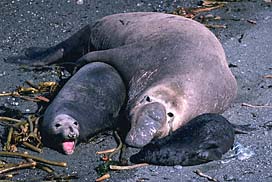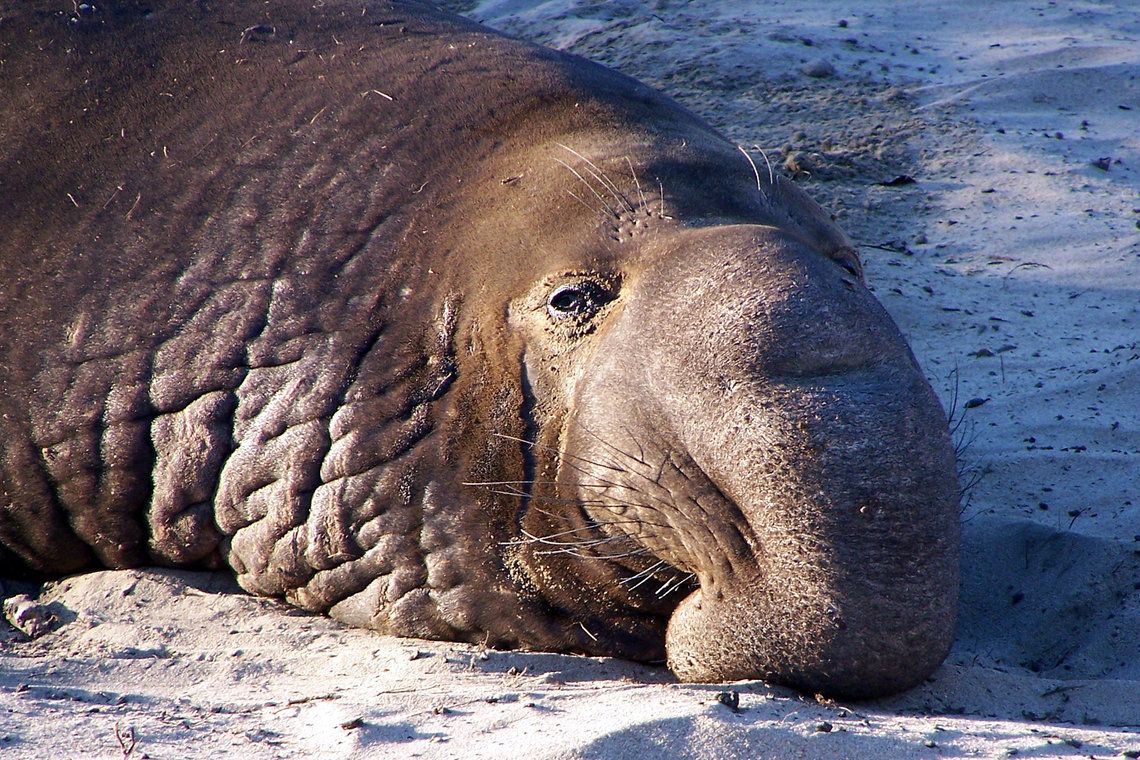Marine Mammals
Description
A very large seal; both sexes have large snout. Snout droops over muzzle in adult male; when inflated during mating season, curves down and can reach back into mouth. Body brown or gray above, lighter below. Chest of male broad, calloused, scarred. Hind flippers have 2 lobes, reduced claws. L male to 13' (4 m), female to 10' (3 m); Wt male to 4,400 lb (2,000 kg), female to 1,320 lb (600 kg).
Habitat
Temperate seas; subtropical sandy beaches for breeding and molting.
Range
Pacific Coast from Gulf of Alaska south to Baja California, Mexico; colonies have been established in U.S. waters on Santa Barbara, San Nicolas, San Miguel, Santa Rosa, Año Nuevo, and Farallon islands, and on mainland coast at Point Año Nuevo and Point Reyes.
Discussion
The Northern Elephant Seal feeds mostly on squid, octopus, and such fish as ratfish, hagfish, small sharks, and other deepwater marine life. A deep feeder, it can remain submerged for up to 80 minutes, often remaining at the surface for four minutes or so before diving again. The deepest dive recorded for an air-breathing vertebrate was 5,187 feet (1,581 m), by a Northern Elephant Seal in 1989. Polygamous but not territorial, this seal is limited by its enormous bulk to breeding on sandy beaches. The bulls arrive on the beaches first, in early December, and begin spectacular fights for territories on which to attract females. Inflating their huge snouts, they rear and threaten each other, the distended nasal pouches causing their snorts and bellows to resonate as much as a mile (1.6 km) away. The main vocal threat is a loud clapping sound made as the male raises up on his flippers, his elongate nose dangling in his mouth. Visual and vocal threats usually suffice, but if not, the bulls lunge at each other with their large canine teeth. By the time the females arrive, most disputes have been settled. About six days after hauling out, a cow gives birth. Of all mammals, the Northern Elephant Seal has the milk richest in fat (54.5 percent) and lowest in water content (32.8 percent); after nursing for a month, the calf weighs 400 pounds (180 kg). The female protects her own pup, and will chase away pups not belonging to her if they stray too far from their own mothers. The biggest danger to a pup is the possibility of starvation if it becomes separated from its mother. A pup that attempts to suckle at a strange cow may be killed, although some orphans are adopted by cows that have lost their own pups. After a pup is weaned, by which time it has grown a silver-gray coat, the mother abandons it to mate. During the breeding season the bull fasts, but the cow feeds periodically. Some females can mate at two years, but most do not mate until their third or fourth year. Bulls are sexually mature at six to seven years, but many do not gain access to females until they are 9 or 10. After mating, the female leaves the rookery and feeds at sea for about two and a half months, then returns to shore to molt in late May. The weaned young remain on the beach until May, living off their fat and practicing swimming nightly. The male departs a little later than the female and remains at sea for several months, regaining part of the 50 percent of its body weight lost during the territorial and mating activities. The males return to shore in late June and July. Both sexes fast while they undergo a molt, during which hair and skin fall off in large patches. After the molt, the seals swim out to sea, where they remain until December, feeding.Killer whales prey upon the young, but healthy adults seem relatively immune to predation. In the 1890s, the Northern Elephant Seal was nearly exterminated by the whaling industry for the oil rendered from its great rolls of blubber. In 1892, a tiny colony of fewer than 20 animals was discovered on Guadalupe Island, off Baja California. It was protected, and the species made a spectacular comeback; the herd now numbers about 115,000 seals, which breed on offshore islands from Baja California north to San Francisco. The Northern Elephant Seal recently has been forced onto mainland beaches owing to the increase in its population. The first birth on the mainland occurred in 1975, and by 1979, almost 100 cows had given birth in a new rookery at Point Año Nuevo, near Santa Cruz, California.




